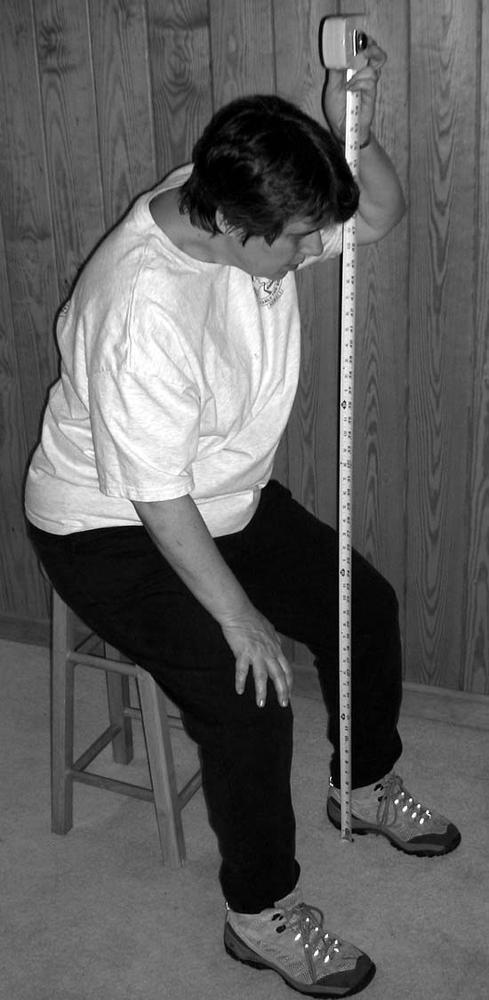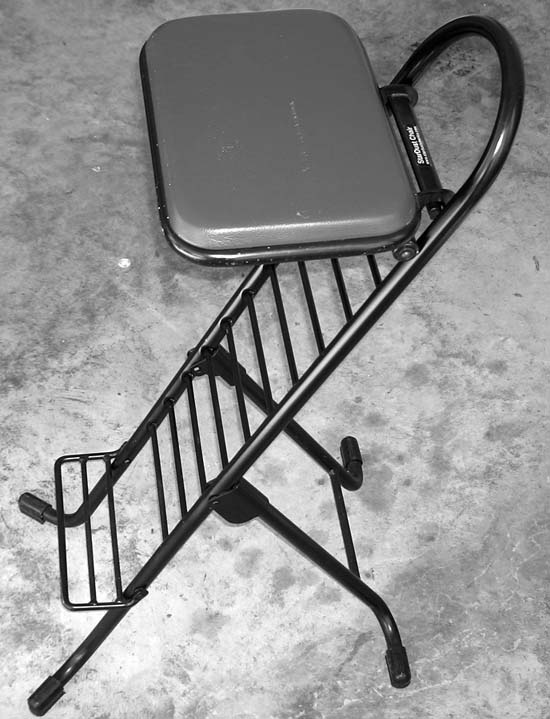Use a good observing chair and add 2” of aperture for free.
We’re always amazed at how many astronomers stand at their telescopes instead of sitting. An old rule of thumb says that observing while comfortably seated is the equivalent of adding a couple extra inches of aperture. It’s true. When you observe seated you are more relaxed and less shaky, and that pays off in terms of being able to see more detail. A good observing chair is probably the single most helpful accessory you can add.
The type of observing chair you need is determined by the type of scope you use. That’s true because the eyepiece position of some types of scopes moves dramatically with changes in the altitude of the object you are observing, while for other types of scopes the change in eyepiece position is much smaller.
For example, when our 10” Dob is pointed at the horizon, its eyepiece height is about 30”. At zenith, the eyepiece height is about 48”. But little observing is done at either horizon or zenith, and for the usual range of elevations the Dob’s eyepiece height remains within the range of 37” to 47”, only a 10” difference. That small difference is easily accommodated just by shifting observing position slightly, so a simple stool of appropriate height serves well for a small or mid-size Dob.
To determine the ideal height for a Dob stool, determine the minimum and maximum eyepiece heights of your scope at the extremes of elevation at which you normally observe. Then, seat yourself on any stool, lean slightly forward in the relaxed posture you would use when looking into the eyepiece, and measure the vertical distance from your eye to the ground, as shown in Figure 4-34. Also measure the upper and lower limits at which you can observe comfortably.
For example, we started with an inexpensive oak barstool with a seat height of 24”. Leaning slightly forward in observing position, Robert’s eye was 51” above the ground, with a comfortable range of 47” to 57”. That range is 10” higher than the range of eyepiece heights we measured for the scope, which means the seat height of the stool needs to be cut from24” to 14”.
Tip
But Robert and Barbara share a scope and an observing stool. Although Barbara is 8” shorter than Robert, her eye height in a relaxed observing posture is only 2” less, giving an ideal seat height for Barbara of 16”. So we compromised and trimmed the stool legs to give a seat height of 15”.
SCTs, MCTs, short-tube refractors, and other tripod-mounted scopes are more problematic. On the good side, although the full arc from 0° to 90° translates to a moderately large vertical change in eyepiece position, the eyepiece height remains relatively constant within the usual range of observing elevations. Unfortunately, such tripod-mounted scopes have two problems of their own:
Tripod legs often intrude, forcing you to sit farther from the scope and lean forward, which reduces the amount of vertical eyepiece shift you can accommodate comfortably.
Instead of having the eyepiece always nearly horizontal or tilted slightly upward, as Dobs do, the eyepiece angle of a refractor or SCT changes with the elevation of the scope. When the scope is horizontal, you must look straight down into the 90° star diagonal, which is then located at the highest point of its arc. When the scope is vertical, you must look horizontally into the diagonal, which is then located at the lowest point of its arc.
We think the best type of observing chair for most tripod-mounted scopes is a drummer’s throne, which is available from any music supply store. Look for a model that allows the seat height to be adjusted quickly over a relatively wide range, such as 16” to 28”. Inexpensive models are available for as little as $25, and the best models cost $150 or more, but something in the $50 to $75 range generally suffices.
Long-tube refractors are the hardest type of scope to deal with because the eyepiece position changes dramatically with changes in elevation. For example, with its tripod legs fully extended, the eyepiece height of our 90mm long-tube refractor is 52” at horizon and only 20” at zenith, a difference of nearly three feet. Even within the usual range of elevations, the refractor’s eyepiece height varies between 42” and 22”, a difference of 20”.That’s much too large to accommodate from a fixed seat or even a drummer’s throne without uncomfortable bending and stretching.
For long-tube refractors, the best seating choice is a fully adjustable astronomy chair, such as the model shown in Figure 4-35, which adjusts from a seat height of only a few inches to more than two feet. An adjustable chair such as this one makes observing much more convenient, particularly with telescopes whose eyepiece height change dramatically with changes in elevation. Commercial models are sold by astronomy retailers like Orion (http://www.telescope.com) and Company Seven (http://www.company7.com) for $200 or so.
If $200 is more than you want to spend on an observing chair, consider building your own. For $35 to $50 in materials and a few hours’ work, you can assemble a fully adjustable observing chair that’s the equal of any of the $200 commercial products. Web sites come and go, so we won’t offer a specific URL, but a quick web search for "Denver observing chair” will turn up dozens of sites with detailed plans for the original Denver observing chair and many derivatives.
Get Astronomy Hacks now with the O’Reilly learning platform.
O’Reilly members experience books, live events, courses curated by job role, and more from O’Reilly and nearly 200 top publishers.



